For the opportunity to review the legendary Nikon ED AF Nikkor 80-200mm 1: 2.8D MKIII many thanks to Dmitry. Dmitry is engaged in the sale of excellent professional lenses, his catalog can be viewed here.
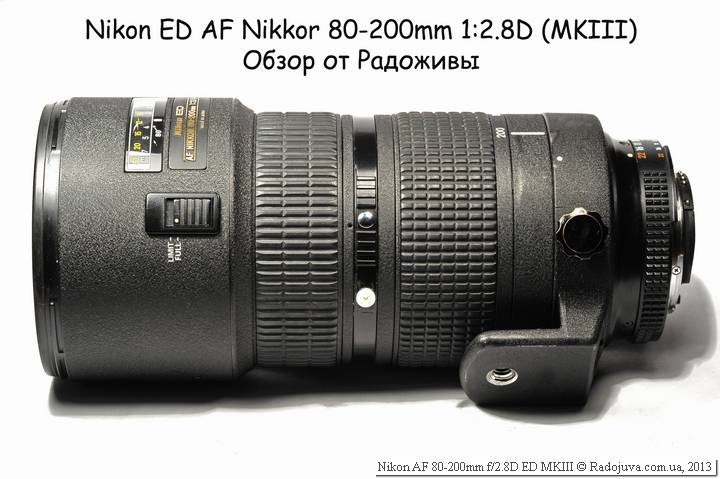
Nikon ED AF Nikkor 80-200mm 1: 2.8D MKIII review
TTX Nikon ED AF Nikkor 80-200mm 1: 2.8D (MKIII)
Focal length: 80-200mm, 2.5X zoom
Diaphragm: F / 2.8-f / 22
Number of aperture blades: 9 pieces
The weight: 1.3kg
Optical design: 16 elements in 11 groups, with 3 ED elements and DIH enlightenment
MDF: 1.5m (1: 5.9 magnification), the lens has a system CRC
Front Filter Diameter: 77 mm
Optically, the third version of the Nikon AF 80-200 / 2.8 lens is no different from the first two versions of MKI and MKII.
A complete and accurate list of all Nikkon Nikkor class 70(80)-(180)200/2.8 autofocus professional lenses:
- Nikon ED AF Nikkor 80-200mm 1: 2.8 (MKI) - November 1987 to September 1992, 16 elements in 11 groups (with 3 ED elements)
- Nikon ED AF Nikkor 80-200mm 1: 2.8D (MKII) - from September 1992 to 1997, 16 elements in 11 groups (with 3 ED elements)
- Nikon ED AF Nikkor 80-200mm 1: 2.8D (MKIII) - January 1997 to present, 16 elements in 11 groups (with 3 ED elements)
- Nikon ED AF-S Nikkor 80-200mm 1: 2.8D Silent Wave Motor (MKIV, AF-S) - from December 1998 to 2003, 18 elements in 14 groups (with 5 ED elements). There are two colors: black and gray.
- Nikon ED AF-S VR-Nikkor 70-200mm 1: 2.8G Vibration Reduction SWM IF (MKV, VRI) from February 2003 to January 2009, 21 elements in 15 groups (with 5 ED elements). There are two colors: black and gray.
- Nikon AF-S Nikkor 70-200mm 1: 2.8GII ED N VR Nano Crystal Coat SWM IF (MKVI, VRII) - July 2009 to present, 21 elements in 16 groups (with 7 ED elements).
- Nikon AF-S Nikkor 70-200mm 1: 2.8E FL ED N VR Nano Crystal Coat (MKVII, E) - from October 2016 to the present, 22 elements in 18 groups (6 ED, 1 FL, 1 HRI element). There is a rare subversion Nikon AF-S Nikkor 70-200mm 1: 2.8E FL ED N VR Nano Crystal Coat Nikon 100th Anniversary (100th Anniversary) - April 2017 to present, features a metallic gray finish with the Nikon 100th Anniversary logo).
- Nikon Nikkor Z 70-200mm 1: 2.8 VR S (MK VIII, Z, S-series) - from January 2020 to the present day. Nikon Z mirrorless version, 21 elements in 18 groups (6 ED, 2 ASP, 1 FL, 1 SR)
- Nikon Nikkor Z 70-180mm 1: 2.8 (MK IX,Z) - from June 2023 to the present day. Version for Nikon Z mirrorless cameras, 19 elements in 14 groups (5 ED, 3 ASP, 1 SUPER ED), diagram from Tamron 70-180mm F / 2.8 Di III VXD Model A056
Old versions Nikon ED 80-200mm f / 2.8D AF Nikkor MKII and MKI are basically different from the Nikon ED 80-200mm f / 2.8D AF Nikkor MKIII using the zoom method and type of enlightenment. The first two versions are often called 'single-ring', since one ring on the lens is responsible for zooming and focusing, and the zoom itself is performed using the piston method. The MKIII version is called 'two roundabout', since there are already two rings on the lens, the first is responsible for zooming, and the second for focusing, while the lens has a classic modern zoom method. All three versions of MKI, II, III have the same optical design, so the image quality of these lenses is quite similar to each other. There are even rumors that the first versions of MKI, MKII are even sharper after the third, I don't believe in that.
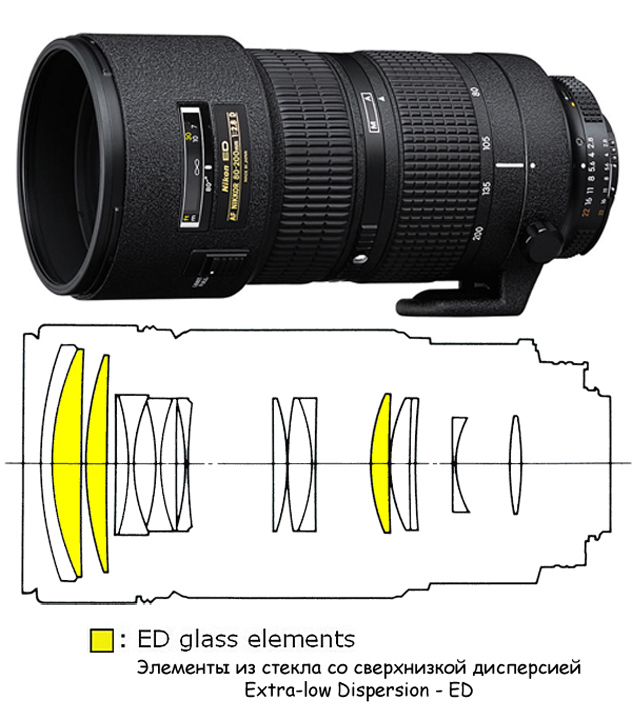
Optical design Nikon ED 80-200mm f / 2.8D AF Nikkor (MKIII)
An interesting point is that until now (at the beginning of 2013) only 2 versions of the lens of the 70 (80) -200 / 2.8 class are produced - this is a nanocrystalline Nikon ED 70-200mm f / 2.8GII AF-S VR N Nikkor (IF) and this old Nikon ED 80-200mm f / 2.8D AF Nikkor (MKIII). The MK3 version has been very, very successful.
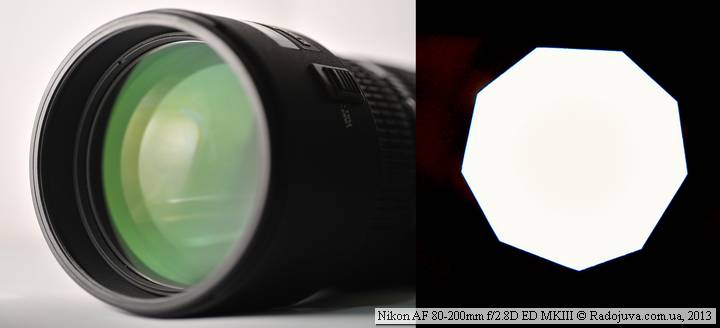
Lens enlightenment Nikon ED AF review Nikkor 80-200mm 1: 2.8D MKIII and aperture view
Nikon AF 80-200mm f / 2.8D ED MKIII made in japanhave been producing the lens since 1996. The build quality is at a very high level, almost the entire lens barrel is made of metal alloy. The zoom and focus rings are rubberized. The lens itself is quite heavy for use on amateur cameras, as it weighs much more than the amateur camera itself. But the appearance of the lens is very 'serious'. The lens uses 'professional' 77 mm filters. On my Nikon D700 sits and looks very nice. Managing the lens is very convenient.
Focusing
Lens does not have internal focus. When focusing, the front lens rides and rotates freely in the lens barrel, but the trunk of the lens does not extendas the lenses are inside the frame. There will be no problems with using filters. Also, while zooming and focusing, the rear lens remains stationary, which reduces the 'vacuum cleaner' effect.
The lens has focus stop. The limiter can switch the lens to one of the modes Full / limit. In 'Full' mode, the lens can focus from infinity to 1.5m. In 'Limit' mode, the lens can focus either from infinity to 2.8m, or from 2.8m to 1.5m. Of course, the lens has a focus scale in meters and feet, as well as an infrared shift indicator for 80mm.
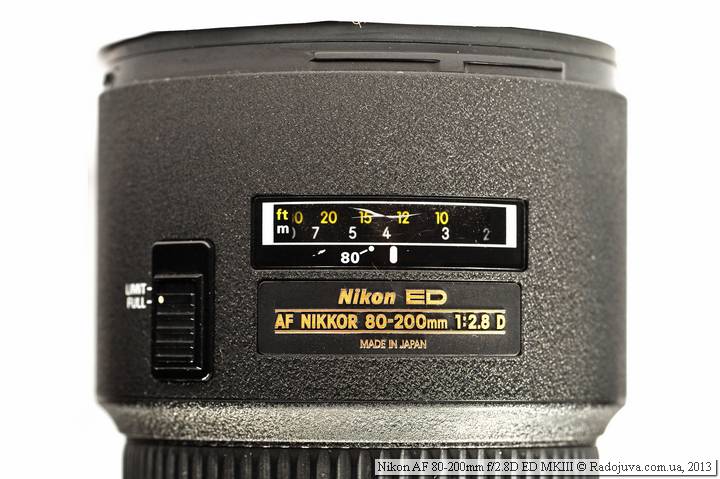
My shabby copy of Nikon 80-200 2.8 MK3
There is a switch on the lens focus mode 'M / A'. In M mode, only manual focus is available. The manual focus ring rotates on 90 degrees in 'Full' mode, and 60 degrees in 'Limit' mode. Manual focusing is quite easy and pleasant. In focus mode 'A', only auto focus is available and the focus ring remains locked. The focus mode switch has a lock button. This button is very inconvenient to use, and the switch itself, which is made in the form of a ring, is inconvenient enough to rotate to switch the focusing mode. The focus mode switch is the only thing I didn't like about this lens.
The autofocus of the lens is fast. When using the 'Limit' mode, little time is spent running the lenses from infinity to the limiting value. In the 'Full' mode, the lenses take much longer to run. Of course, due to the camera's screwdriver being used to focus, the lens emits quite loud noise with auto focus.
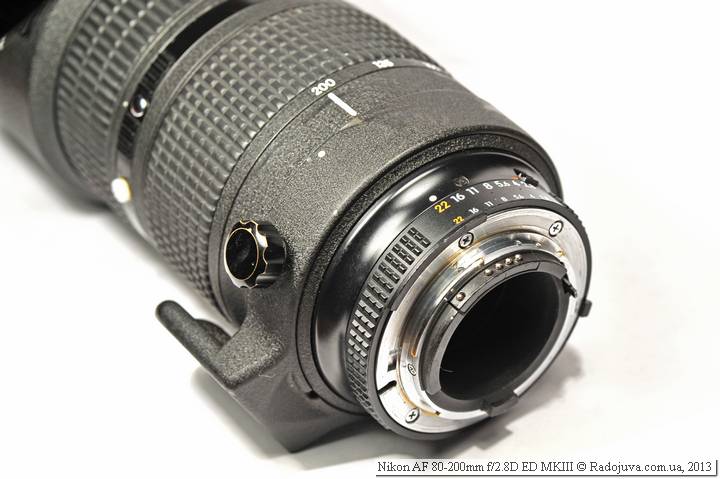
View of the Nikon ED AF Nikkor 80-200mm 1: 2.8D MKIII lens from the bayonet side
It's important: auto focus with this lens is available only when using him on cameras with built-in motor focusing.
Exact list Nikon DSLR cameras with a built-in focus motor, on which this lens will focus automatically:
- D1, D1h, D1x, D2x, D2xs, D2h, D2hs
- D3, D3x, D3s, D4, D4s, D5, D6
- Df
- D50, D70, D70s, D80, D90
- D7000, D7100, D7200,D7500
- D100, D200, D300, D300s,D500
- D600, D610, D750, D780
- D700, D800,D800E, D810, D810a, D850
- Fujifilm FinePix S1 Pro, S2 Pro, S3 ProS3 Pro UVIR, S5 ProIS Pro
- Kodak DCS PRO 14n, DCS Pro SLR/n
Exact list Nikon DSLR cameras without a built-in focus motor, on which this lens will not focus automatically:
Only auto focus and sound confirmation of focus will not work with these cameras, all other important functions, such as automatic exposure metering and automatic iris control, will work well.
You will find a lot of useful information on the types of cameras and lenses Nikon here.
Important: the lens has an aperture control ring. In order for the lens to start working normally on modern CZKs, you need to set the f / 22 value on the lens and snap a special switch near the aperture control ring. After such a manipulation, the aperture can be controlled from the camera, in more detail in the section on Non-G type lens.
The lens has tripod socket with foot. The socket cannot be removed. The socket foot can rotate around the lens and be fixed using a special clip.
Sample photos on Nikon AF 80-200mm f / 2.8D ED MKIII and full frame
All photo without processing. All photos in the gallery below were shot with a Nikon ED 80-200mm f / 2.8D AF Nikkor (MKIII) lens and camera Nikon D700, RAW, NL image management mode, converted to JPEG using VinewNX 2 with automatic detection BB (Calculate Automaticaly), reduced size to 3MP and imprinted data from EXIF.
Sample photos on Nikon AF 80-200mm f / 2.8D ED MKIII and cropped camera
All photo without processing. All photos in the gallery below were shot with a Nikon ED 80-200mm f / 2.8D AF Nikkor (MKIII) lens and camera Nikon D80, RAW, PO picture management mode, converted to JPEG using VinewNX 2 with automatic detection BB (Calculate Automaticaly), reduced size to 3MP and imprinted data from EXIF.
When using the lens on Nikon DX cameras EGF will be 120-300mm. Even on crop, this lens remains just a gorgeous tool in the hands of the photographer. The lens is well suited for portraiture, wedding photography, for wildlife photography, sports.
Personal experience
There are no significant complaints to the Nikon AF 80-200mm f / 2.8D ED MKIII, it is really a worthwhile lens, a good budget option to replace the expensive 70-200 / 2.8GII N VR. Many people write that the disadvantage of the lens is its weight, for me it is rather a virtue. Great weight helps take pictures with hand without grease. Of course, on F / 2.8 it’s not as sharp as a razor, but picture quality is really high. The lens may still use a lens hood HB-7, with a lens hood, the lens looks generally irresistible. Nikon 80-200 F2.8 MK3 can be considered one of the three lenses of a professional photographer, who should be in a case.
You can see the prices for the lens in popular stores. at this link, or in the price block below:
Comments on this post do not require registration. Anyone can leave a comment. Many different photographic equipment can be found on AliExpress.
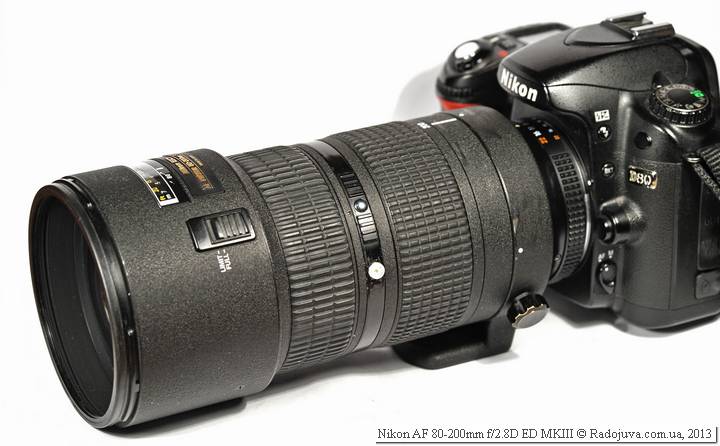
Lens view Overview Nikon ED AF Nikkor 80-200mm 1: 2.8D MKIII on Nikon D80
Conclusions:
Nikon ED AF Nikkor 80-200mm 1: 2.8D (MKIII) - great professional lens. Good value for money. I recommend.
Material prepared Arkady Shapoval. Training/Consultations | Youtube | Facebook | Instagram | Twitter | Telegram
































Nikon Zoom-Nikkor AF 80-200 / 2.8 D ED, III “double ring” version with a tripod foot. or still - Nikon 80-400mm f / 4.5-5.6D ED VR AF Zoom-Nikkor. I wish I knew for sure!
Definitely 80-200 / 2.8!
Hello, I read a lot, compared Nikon Zoom-Nikkor AF 80-200 / 2.8 D ED mkIII and sigma af 70-200 f / 2.8 ex dg os hsm, as a result I was completely confused which one to buy ... Do you have any experience of using this sigma ?
And here I am planning to sell it. He did not lie in my hand. It has been lying for a long time - there was no bag to carry him (I made a bag), then somehow it’s not that right ... I’m used to shooting very close to the model and I am more shocked by the lack of shirik. Something like 12-24 or 15-30. And on the long end I have a Sigma 55-200 crop lens - sharp, fast and light.
But the lens - if objectively)) - is good. Even more. The portrait portrait is so amazing in general. And how many things I shot them “far away”! But here ... Not in the arm - it happens ...
I have been using this lens for more than a year in conjunction with the D80.
What can I say, the glass is really chic. Quick focus, beautiful drawing.
For this year, Nirazu did not regret that I have it.
Good day, is it worth taking this lens on the D300? or better fix motor 85 1.8?
Is it worth taking on d5100?
Sanya, no. The D5100 does not have a “screwdriver”, and, alas, there will be no autofocusing either.
Good evening! Thank you interesting! But I would like to know more about the function - infrared shift indicator for 80mm. How to use it, and most importantly - what does it serve?
Arkady, hello, I have a question for you: why do you need an infrared shift indicator, maybe this is not so important, but I just want to know. thank you in advance_)
For infrared photography. In this mode, focus adjustments must be made according to the R mark.
many thanks for the answer)
The D800 focuses instantly almost like Nikon 24-70.
Hello. Tell me, is it worth buying such a lens in excellent condition for 850 ye, in the presence of 70-300 VR?
I bought one yesterday. First impression - the lens is simply amazing!
As for the sharpness - both at 2.8 and at 4 - it is the same, razor-sharp, in conjunction with the D600.
Hello Arkady, thank you very much for the reviews, it is always very interesting to read! And also creative and financial success))
I need your advice, I have long been tormented by the pangs of choice: is it worth changing your Nikon 70-300 mm f / 4.5-5.6 VR to a lens from this review or is it better to leave it and buy yourself a Nikon 85 mm f / 1.4D .. the lens is needed for shooting portraits (including shooting a wedding photo). Thank you in advance for your reply.
Should I take for the D3200?
No, due to the lack of auto focus.
Good day. Faced a choice: they offer 80-200 2.8 MK3 in good condition but the AF / MF mode dial does not work (the button is not pressed), for 16 thousand, and exactly the same but in excellent condition and completely working, but for 25 000. It costs repair rings and the general condition of the lens 9?
I prefer not to mess with lenses that have obvious problems because you never know what will be in the middle when he gets to the master.
Arkady, thanks for your painstaking and very useful work!
I would like to know your opinion on the current optimal Nikon TV set from the following set:
It is quite possible to find glass for reasonable money from this review or used 80-200 4th generation. There is a relatively inexpensive, but dark 70-300 (it seems like a stub and a motor, but I do not like the resizing of the glass wildly) and there is a new 70-200 with a 1: 4 aperture but with a new stabilization system but at a price of 10k UAH. The photographic position is very active, but using only cropped carcasses.
I have 80-200 afs very pleased and would choose instead of 70-300, but all of necessity, artistic portraits for example 80-200, hunting 70-300 bp.
Hello)
Please clarify about the sharpness at 2.8
Is this glass suitable for shooting fast-moving objects?
Is it worth it to order through ebay?
the matter is basically risky, but I personally ordered 6 times and what was stated in the description came, the Japanese and Europeans follow what they write and pack well, so under good conditions the next time I will safely order from ebay;
there’s also Amazon and several similar stores, I’ve never met with deception,
Once the truth was sent by mistake to Petropavlovsk-Kamchatsky, but after 2 months the parcel arrived in my hometown, which is located in the North Kazakhstan region.
Most importantly, read the "condition" clause carefully, good luck.
please tell me this lens is suitable for nikon d3100
There will be no auto focus - no screwdriver.
Na Nikon 3000 vseh modelei i 5000 vseh modelei D40, D40X, D60 ne budet avtofocusa.
HOW WORKS ON D800 HOW DOES ITSELF
Arkady hello, for more than a year I have been using your feedback as a guideline, please tell me how fundamental is the difference between the 80-200 version 1 and the third? The 3rd version seems to be "smarter", but really the 3st version in this case is so careless, in the TTL mode in the 1st version the FR is supposedly not transmitted, but the carcass itself can do this, I can't understand these subtleties.
At the moment I want to buy, one of the 1st version for $ 500 and the second 3rd for $ 600, but it has small chips from a crashed filter, you can’t see the defect in the frames, what would you choose?
thank you in advance!
Structurally different lenses, different focusing speeds. MK1 does not transmit information about the distance, not FR, details here - https://radojuva.com.ua/2012/03/nikon-lenses/#d-nikon
The question on this lens, I have been with it for 3 months now, is very satisfied. But I can not understand the purpose and purpose of the Full / Limit switch for focusing in any way.
In 'Full' mode, the lens can focus from infinity to 1.5m. In 'Limit' mode, the lens can focus either from infinity to 2.8m, or from 2.8m to 1.5m
What can force me to put myself such a restriction? Focus speed is not critically faster. I use only in Full mode. Any opinions? Thanks.
Exactly what the focus speed is. The lens does not focus on the whole scale, but is limited to a short segment. It’s convenient if you are filming a report or something that is approximately the same distance from you.
I sell this lens. Absolutely new! Lied for many years as unnecessary.
Hammer reference http://molotok.ru/show_item.php?item=4243306959
In Perm, I can transfer personally.
info@mail.ru